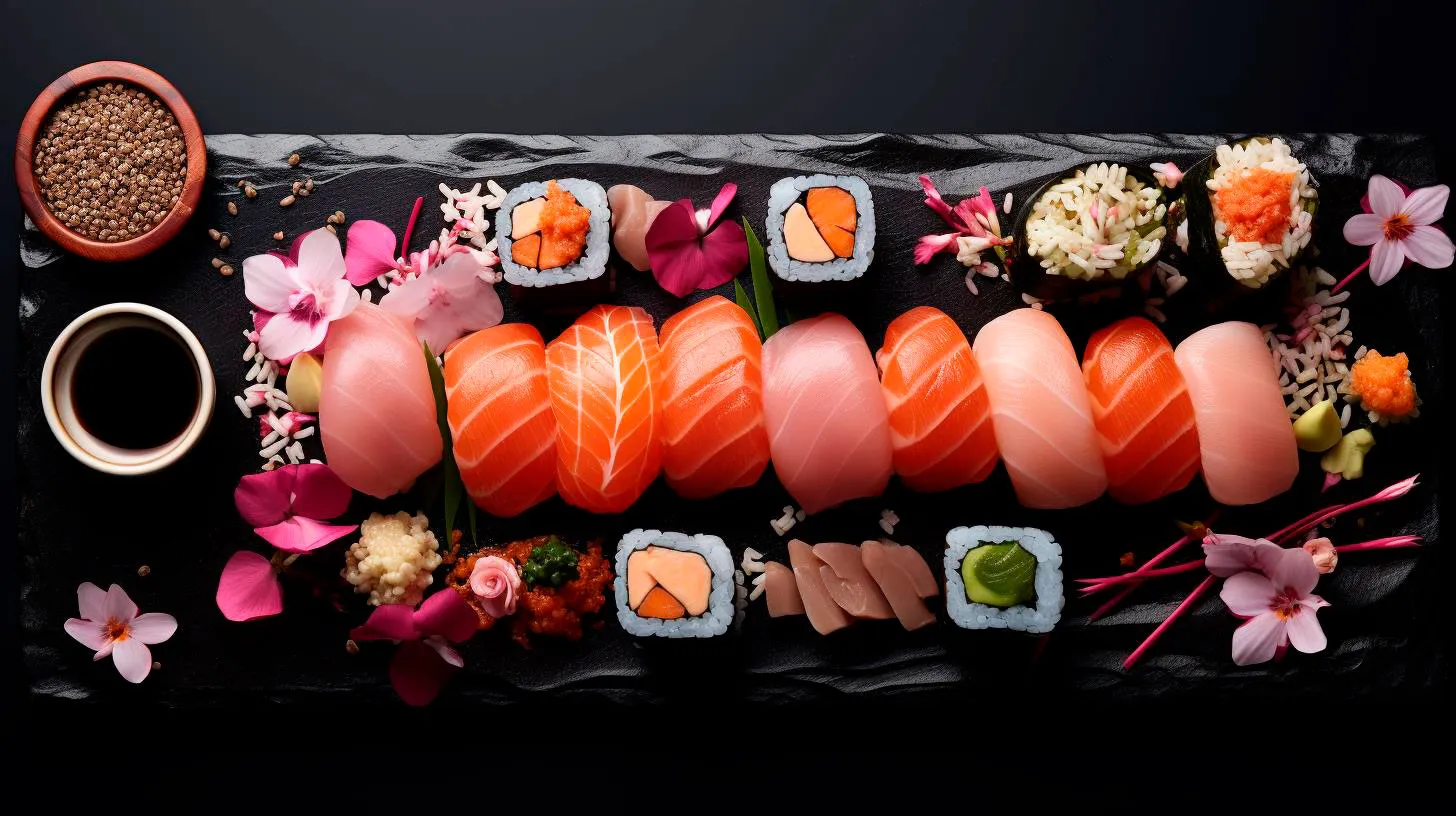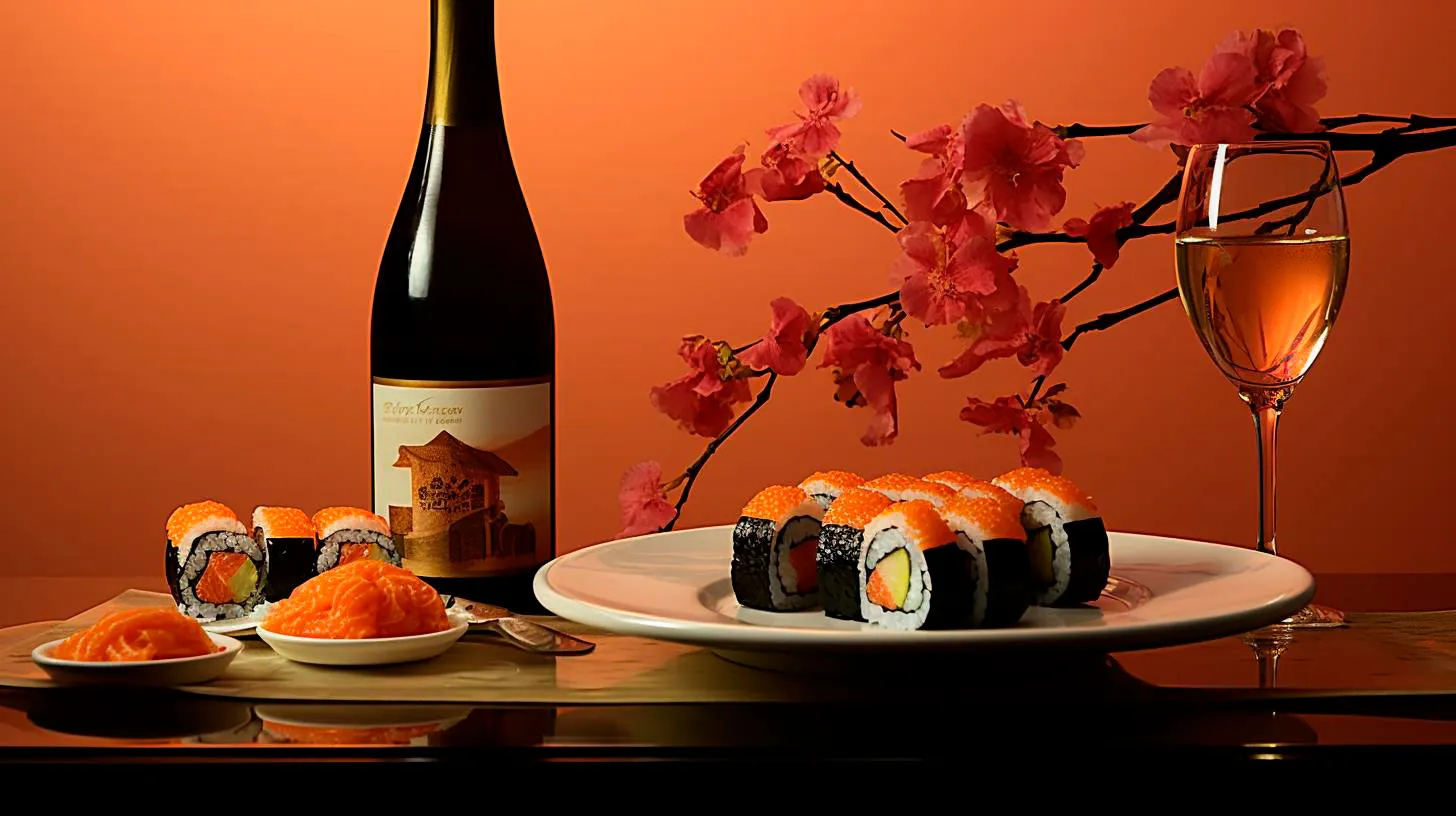Balancing Flavor and Nutrition: The Sushi Conundrum
In this blog article, we’ll explore the sushi conundrum and delve into how to strike the perfect balance between flavor and nutrition.
The Nutritional Aspects of Sushi
Sushi, primarily associated with Japanese cuisine, is heralded for its artistic presentation and diversity. From traditional nigiri and sashimi to creative rolls, there is something to satisfy every palate. While sushi offers a wide range of flavor profiles, it’s crucial to understand the nutritional aspects to make informed choices.
Here are some key takeaways:
- Sushi is a good source of lean proteins like fish and seafood. Fish like tuna and salmon are packed with omega-3 fatty acids, which promote a healthy heart.
- Seaweed, a common ingredient in sushi, is rich in iodine and vitamin K. It helps regulate thyroid function and promotes blood clotting.
- Sushi rice, although a source of carbohydrates, contains vinegar, which aids digestion and provides a unique tangy flavor.
- Vegetable-based sushi options, such as avocado or cucumber rolls, offer essential vitamins, minerals, and dietary fiber.
However, one must be cautious about certain aspects when consuming sushi:
- Tempura rolls, which are deep-fried, may be delicious but are high in calories and unhealthy fats.
- Soy sauce, typically served with sushi, is high in sodium. Opt for reduced-sodium versions or use it sparingly.
- Spicy mayo and cream cheese, popular toppings in westernized sushi rolls, can add extra calories and saturated fats.
Flavorful Innovations
Sushi is an ever-evolving culinary art form, constantly adapting to new tastes and preferences. Chefs worldwide experiment with unique ingredients and techniques to create innovative rolls that tantalize the taste buds. These exciting flavor enhancements further complicate the sushi conundrum as we aim to balance both nutrition and taste.
Consider these flavorful innovations:
- Using quinoa instead of traditional sushi rice to increase the protein and fiber content while reducing carbohydrates.
- Exploring vegetarian sushi options that incorporate marinated tofu, grilled mushrooms, or pickled vegetables for added flavor profiles.
- Utilizing alternative sauces such as ponzu, miso glaze, or yuzu vinaigrette to add depth and uniqueness to sushi rolls.
It’s worth noting that while novel flavors can enhance the sushi experience, they may also introduce new nutritional considerations. Keeping an eye on ingredient combinations and portion sizes is integral to strike the right balance.
Health-Conscious Sushi Choices
With growing health consciousness, sushi lovers are increasingly seeking healthier options that align with their dietary preferences. Restaurants and sushi chefs have responded to these demands, offering alternative choices that cater to various dietary needs.
Here are some health-conscious sushi options:
- Sashimi: Enjoy slices of fresh fish or seafood without rice, reducing the calorie and carbohydrate content.
- Brown Rice Rolls: Opt for sushi rolls made with nutrient-rich brown rice instead of white rice.
- Hand Rolls: These cone-shaped rolls contain a generous amount of fresh ingredients and are typically lighter on calories.
- Gluten-Free: Sushi rolls wrapped in cucumber or soy paper provide a gluten-free alternative.
By choosing these healthier alternatives, you can savor the flavors of sushi while aligning with your nutritional goals.
The Key Takeaway
Sushi offers an exciting blend of flavor and nutrition, but striking the right balance is essential. By understanding the nutritional aspects, exploring flavorful innovations, and making health-conscious choices, sushi enthusiasts can enjoy this culinary delight without compromising their well-being.
So, the next time you visit your favorite sushi restaurant, indulge in the artistry and mindfulness that goes into each roll. Remember to relish the flavors, keep an eye on the nutritional aspects, and make choices that align with your personal preferences and health objectives.
Unlocking the Secrets of Healthy Sushi Choices
The Benefits of Sushi
Before diving into the secrets of healthier sushi choices, let’s explore the benefits of incorporating sushi into your diet:
- Rich in Omega-3 Fatty Acids: Sushi, especially those containing fatty fish like salmon and tuna, are excellent sources of omega-3 fatty acids. These essential fatty acids are known to support heart health and improve brain function.
- High in Protein: Sushi is a great source of high-quality proteins, perfect for those following a low-carb or high-protein diet.
- Low in Calories: Sushi, when consumed in moderation, can be a low-calorie and satisfying meal option. It allows you to enjoy a flavorful and fulfilling meal without excessive calorie intake.
- Rich in Antioxidants: Sushi is often accompanied by nutrient-rich ingredients like seaweed, ginger, and wasabi. These ingredients are packed with antioxidants that help fight inflammation and support a healthy immune system.
Choosing the Healthiest Sushi Options
Now that you understand the benefits of sushi, let’s delve into the secrets of making healthy choices when ordering your favorite rolls:
Opt for Fresh and High-Quality Ingredients
The freshness and quality of ingredients play a crucial role in making your sushi choice healthier. Here are some tips for selecting the best options:
- Choose a reputable sushi restaurant known for their high-quality fish and ingredients.
- Look for keywords like “sashimi-grade” or “freshly caught” on the menu to ensure the fish has been handled and stored properly.
- Consider opting for sushi restaurants that prioritize sustainability and source their fish from responsible suppliers.
Focus on Lean Protein Options
Protein is a vital component of sushi, but not all options are equal. To make healthier choices, consider the following:
- Opt for lean protein sources like tuna, salmon, yellowtail, or shrimp.
- Avoid fried or tempura-based rolls, as they tend to be higher in calories and unhealthy fats.
- Consider sushi options with tofu or edamame for a plant-based alternative.
Be Mindful of Portions and Condiments
While sushi itself can be a healthy choice, portions and condiments can impact its nutritional value. Keep the following in mind:
- Avoid excessive mayonnaise-based sauces and opt for lighter options like Ponzu sauce or citrus-based dressings.
- Enjoy sushi in moderation and be mindful of portion sizes. Balance your meal with other nutritious options like miso soup, salad, or steamed vegetables.
- Limit the intake of soy sauce to reduce sodium consumption.
Key Takeaways
It’s time to unlock the secrets and make healthier sushi choices:
- Enjoy the benefits of sushi, including omega-3 fatty acids, high-quality proteins, and low-calorie options.
- Choose sushi restaurants that prioritize fresh and high-quality ingredients.
- Focus on lean protein options like tuna, salmon, or shrimp.
- Be mindful of portion sizes and avoid excess condiments.
- Explore plant-based alternatives like tofu or edamame for a healthier sushi experience.
Remember, making healthier sushi choices is all about balance and variety. By following these secrets, you can indulge in this delicious cuisine guilt-free while nourishing your body with beneficial nutrients.
Exploring the Science Behind Sushi Flavorful Experience
So, grab your chopsticks and let’s dive in!
The Umami Sensation
Sushi owes much of its deliciousness to the presence of umami, the fifth taste. Umami is often described as a savory, meaty, or brothy taste that adds depth and complexity to food. This taste sensation is caused by the presence of glutamic acid, an amino acid naturally found in certain ingredients used in sushi-making.
Key takeaways:
- Umami is the fifth taste that enhances the flavor of sushi.
- Glutamic acid is responsible for the umami taste sensation.
The Role of Rice
The rice used in sushi plays a crucial role in enhancing its flavor. Sushi rice is seasoned with a mixture of rice vinegar, sugar, and salt, known as sushi vinegar. This combination not only gives the rice its characteristic tangy flavor but also acts as a natural preservative. The vinegar inhibits the growth of bacteria, making it safe to consume raw fish in sushi.
Key takeaways:
- Sushi rice is seasoned with vinegar, sugar, and salt.
- Sushi vinegar preserves the rice and adds a tangy flavor.
- Vinegar inhibits bacterial growth, ensuring sushi’s safety.
The Secrets of Fresh Fish
Freshness is imperative when it comes to sushi. The quality and flavor of seafood used in sushi are directly influenced by its freshness. Sushi chefs pay meticulous attention to sourcing the freshest fish available. The texture, taste, and aroma of the fish should be pristine in order to create a unforgettable sushi experience.
Key takeaways:
- Fresh seafood is crucial for the taste and quality of sushi.
- Sushi chefs prioritize finding the freshest fish.
Soy Sauce and Wasabi: Enhancing the Experience
Soy sauce and wasabi are essential accompaniments to sushi, adding an extra layer of flavor. Soy sauce, or shoyu, is made from fermented soybeans and wheat, providing a salty and savory taste. On the other hand, wasabi, often referred to as Japanese horseradish, is known for its unique pungent heat that clears the sinuses and adds a peppery kick to the sushi.
Key takeaways:
- Soy sauce adds a salty and savory taste to sushi.
- Wasabi provides a pungent heat and peppery kick.
The Importance of Presentation
The visual appeal of sushi is just as important as its taste. Sushi chefs put great effort into creating visually stunning dishes by using a variety of techniques such as colorful garnishes, intricate cuts, and artistic arrangements. Aesthetically pleasing sushi not only enhances the overall dining experience but also stimulates the appetite.
Key takeaways:
- Sushi chefs focus on creating visually appealing presentations.
- Aesthetically pleasing sushi stimulates the appetite.
Conclusion
Sushi’s incredible taste experience is a result of a harmonious combination of umami, fresh fish, seasoned rice, and complementary condiments like soy sauce and wasabi. The attention to detail in sourcing the finest ingredients, along with the focus on presentation, elevates sushi to a culinary masterpiece. Whether you are a sushi connoisseur or a newcomer, understanding the science behind the flavors enriches your overall sushi appreciation.
So, the next time you indulge in a delectable sushi roll, take a moment to savor the symphony of flavors and appreciate the culinary mastery behind this worldwide phenomenon!



